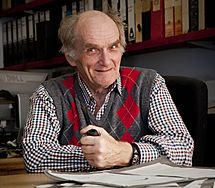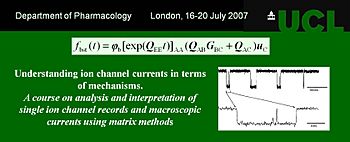David Colquhoun facts for kids
Quick facts for kids
David Colquhoun
FRS MAE
|
|
|---|---|

David Colquhoun in 2013
|
|
| Born | 19 July 1936 Birkenhead, Cheshire, England
|
| Alma mater |
|
| Known for |
|
| Awards | Humboldt Prize (1990) |
| Scientific career | |
| Fields |
|
| Institutions | |
| Thesis | The characterisation and adsorption of sensitising antibodies (1965) |
| Doctoral advisor | W.L.M. Perry W.E. Brocklehurst |
David Colquhoun FRS MAE (born 19 July 1936) is a British pharmacologist at University College London (UCL). He has contributed to the general theory of receptor and synaptic mechanisms, and in particular the theory and practice of single ion channel function. He held the A.J. Clark chair of Pharmacology at UCL from 1985 to 2004, and was the Hon. Director of the Wellcome Laboratory for Molecular Pharmacology. He was elected a Fellow of the Royal Society (FRS) in 1985 and an honorary fellow of UCL in 2004. Colquhoun runs the website DC's Improbable Science, which is critical of pseudoscience, particularly alternative medicine, and managerialism.
Contents
Early life and education
Colquhoun was born on 19 July 1936 in Birkenhead, UK. He was educated at Birkenhead School and Liverpool Technical College. After working unhappily as an apprentice pharmacist, he was motivated to go into research. He obtained a BSc from the University of Leeds with a specialisation in pharmacology, and went on to complete a PhD at the University of Edinburgh where he studied the binding of immunoglobulins to lung tissue. His supervisors were Walter Perry and W.E. Brocklehurst. During his education, Colquhoun developed an interest in statistics and random processes, which would influence his research in years to come.
Upon completion of his PhD, Colquhoun conducted further research (largely unsuccessful) on immunological problems at UCL from 1964 to 1969. During this time he published a book on statistics. Following this, he completed stints at Yale University and at the University of Southampton. He returned to the pharmacology department at UCL in 1979, where he has remained since. In 2007, Malcolm Grant brought an end to the department, ending its eminent 102-year history (see Department of Pharmacology at University College London, 1905 – 2007).
Scientific career
Colquhoun researched the nature of the molecular interactions that cause single ion channels to open and shut, and what it is that controls the speed of synaptic events. The invention and successful application of the patch clamp technique by Erwin Neher and Bert Sakmann allowed the individual openings and closings of single ion channels to be observed and recorded. However, experimentally observed recordings are random in nature. With the help of the statistician Alan G. Hawkes, Colquhoun developed a statistical method to interpret the data and test putative quantitative mechanisms for how ion channels function.
Work with single ion channels
In 1977 Colquhoun and Hawkes predicted that ion channel openings would be expected to occur in brief bursts rather than as single openings, and this prediction was verified in experiments with Bert Sakmann, in Göttingen and London (1981). This work led to the first solution of the classical pharmacological problem of measuring separately the affinity and efficacy of an agonist. In the context of ion channels, this problem is also known as the binding/gating problem. This problem remains unsolved for G protein-coupled receptors, because it was shown in 1987 that the classical methods for determining affinity and efficacy were based on a misapprehension.
The 1985 paper was later nominated as a "classic" by The Journal of Physiology. In 1982 Colquhoun & Hawkes published a paper on the theory of bursts (and clusters of bursts) which gave a general expression for the distribution of the burst length (shown here on the design for a mug for those who attend a course designed to teach the mathematics needed for the equation).
It was clear that the burst length was what controlled the decay rate of synaptic currents, though the formal relationship was not derived until 1998.
Missed short events
Although the general theory of single channel behaviour was completed in 1982, it could not be used in practice for fitting mechanisms to data, because the recording apparatus is incapable of detecting events shorter than, at best, about 20 microseconds. The effect of missing short shuttings is to make openings appear to be longer than they really are (and likewise for shuttings). To use the method of maximum likelihood it was essential to derive the distribution of the length of what is actually seen, apparent open times and apparent shut times. Although the Laplace transform of these distributions was known, it was thought that they were not invertible until Hawkes and Jalali found an exact solution in 1990. The exact solution was a piecewise expression that got progressively more complicated as the length of the opening (or shutting) increased. The solution became usable in practice after Hawkes and Jalali discovered an elegant asymptotic solution in 1992. The application of the exact solution to joint and conditional distributions in 1996 opened the door to maximum likelihood fitting, which was implemented in a computer program, HJCFIT, which has been the basis of subsequent experimental work. The distributions of apparent open and shut times are often referred to as HJC distributions (for Hawkes, Jalali, Colquhoun).
Intermediate shut states
All the early work was based on mechanisms that were essentially generalisations of the simple scheme proposed by del Castillo & Katz in 1957, in which the receptor existed in only two conformations, open and shut. It was only when the glycine receptor was investigated that it was realised that it was possible to detect an intermediate shut state (dubbed the "flipped" conformation), between the resting conformation and the open state. Subsequently, it was discovered that this extra "flipped" conformation was detectable too in the nicotinic acetylcholine receptor. Lape et al. (2008) found that partial agonists were partial, not, as had been supposed since 1957, because of a deficiency in the open reaction itself, but because of a deficiency at an earlier stage, a reluctance to move from the resting conformation to the intermediate shut state that precedes opening. The actual shut-open conformation change turned out to be much the same for partial agonists as it was for full agonists. In the original formulation the flipping reaction was supposed to be a concerted transition. The essentials of this new mechanism were confirmed by Mukhtasimova et al. (2009), who generalised it to the case where the subunits can flip independently.
Statistical inference
After retiring from single ion channel work, Colquhoun maintained an interest in statistical inference. His 2014 paper, An investigation of the false discovery rate and the misinterpretation of p-values, contributed to the p-value debate, and to the discussion of reproducibility in science. This paper has been followed by others which have explored the basis of inductive inference, and which have investigated in more depth the alternatives to using p values. The hazards of reliance on p-values was emphasised in by pointing out that even observation of p = 0.001 was not necessarily strong evidence against the null hypothesis. Despite the fact that the likelihood ratio in favour of the alternative hypothesis over the null is close to 100, if the hypothesis was implausible, with a prior probability of a real effect being 0.1, even the observation of p = 0.001 would have a false positive risk of 8 percent. It would not even reach the 5 percent level. It was recommended that the terms "significant" and "non-significant" should not be used. P values and confidence intervals should still be specified, but they should be accompanied by and indication of the false positive risk. It was suggested that the best way to do this is to calculate the prior probability that would it would be necessary to believe in order to achieve a false positive risk of, say, 5%. Or, perhaps more simply, the p value could be supplemented by the minimum false positive risk, FPR50, -that calculated for a prior probability of 0.5. Although this would be safe only for plausible hypotheses, it would be a great improvement on giving on p values and confidence intervals. The calculations can be done with R scripts that are provided, or, more simply, with a web calculator.
Awards and honours
Colquhoun was elected a Fellow of the Royal Society (FRS) in 1985 and awarded the Humboldt Prize in 1990.
Personal life
In 1976, he married Margaret Ann Boultwood. They have a son and two granddaughters.
Outside academia, Colquhoun has enjoyed (in chronological order) boxing, sailing (21 ft, and later 31 ft sloops), flying light aircraft, long-distance running (10 km, half-marathon and marathon), and mountain walking. In 1988 he did the London marathon in 3 hours 57 minutes. For his 65th birthday, in 2001, he walked across the Alps (Oberstdorf, Germany, to Merano, Italy).


